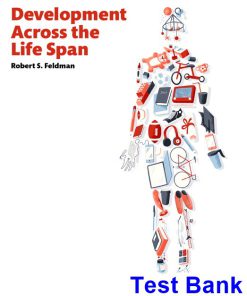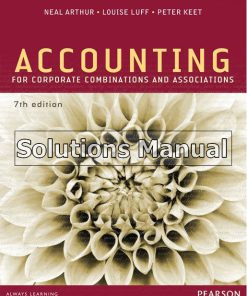Accounting Information for Business Decisions 1st Edition Cunningham Test Bank
$26.50$50.00 (-47%)
Accounting Information for Business Decisions 1st Edition Cunningham Test Bank.
You may also like
Accounting Information for Business Decisions 1st Edition Cunningham Test Bank

Product details:
- ISBN-10 : 0030315093
- ISBN-13 : 978-0030315091
- Author: Cunningham, Billie M., Nikolai, Loren A., Bazley, John D.
This text offers an integrated approach to teaching managerial and financial accounting course topics for the Introductory or principles of Accounting course. Designed to help students understand how to use both managerial and financial accounting information to make decisions, this is the only introductory accounting book to have an entire chapter devoted to creative and critical thinking. Information and analysis of real-world companies, business issues and values, and international issues are integrated throughout the text. A non-technical approach makes this text suitable for the non-specialist and specialist alike.
Table contents:
Chapter 1: Introduction to business accounting and the role of professional skills
1.1 Factors affecting the complexity of a changing business environment
1.2 Business enterprise categories
1.3 Business structures
1.4 The accounting system
1.5 Ethics in business and accounting
1.6 The accountant in a changing society
Study tools
Chapter 2: Developing a business plan: Cost–volume–profit analysis
2.1 Planning in a new business
2.2 Cost–volume–profit (CVP) planning
2.3 Using CVP analysis
2.4 Other planning issues and effects
Study tools
Appendix: CVP analysis for cups of coffee
Chapter 3:
Developing a business plan: Applied budgeting
3.1 Why budget?
3.2 Operating cycles
3.3 The budget as a framework for planning
3.4 Using the master budget in evaluating the business’s performance
Study tools
Chapter 4: The accounting system: Concepts and applications
4.1 Financial accounting information and decision making
4.2 Basic concepts and terms used in accounting
4.3 Components of the accounting equation
4.4 Accounting for transactions to start a business
4.5 Expanding the accounting equation
4.6 Recording daily operations
4.7 End-of-period adjustments
Study tools
Chapter 5: Recording, storing and reporting accounting information
5.1 Accounts
5.2 Accounting cycle
5.3 Recording (journalising) transactions
5.4 Posting from journals to the accounts
5.5 Trial balance
5.6 Preparing adjusting entries
5.7 Adjusted trial balance
5.8 Preparing the financial statements
5.9 Preparation of closing entries
5.10 Modifications for companies
5.11 Other journal entries
Study tools
Chapter 6: Internal control: Managing and reporting working capital
6.1 Working capital
6.2 Cash
6.3 Accounts receivable
6.4 Inventory
6.5 Accounts payable
Study tools
Chapter 7: The income statement: Components and applications
7.1 Why the income statement is important
7.2 Measuring financial performance: The income statement
7.3 Defining and classifying revenues/income
7.4 Defining and classifying expenses
7.5 Evaluating the income statement using ratios
7.6 Linking profit to owner’s equity and closing the accounts
Study tools
Appendix: Calculating the cost and the amount of inventory
Chapter 8: The balance sheet: Components and applications
8.1 Why the balance sheet is important
8.2 The accounting equation and the balance sheet
8.3 Using the balance sheet figures for evaluation
8.4 Evaluating financial flexibility
8.5 Limitations of the income statement and the balance sheet
8.6 Business activity statements (BAS)
Study tools
Chapter 9: The cash flow statement: Components and applications
9.1 Understand the importance of the cash flow statements to
organisations and users
9.2 Identify the types of transactions that generate cash inflows and outflows
9.3 The organisation of the cash flow statement
9.4 Construct cash flow statements based on the direct method
9.5 Analysis of the cash flow statement
9.6 Calculate the relevant cash flow ratios
Study tools
Appendix: Indirect method for reporting cash flows from operating activities
Chapter 10: Sustainable and profitable business practices
10.1 Corporate social responsibility (CSR)
10.2 The triple bottom line
10.3 Triple-bottom-line accounting: Practical measures
10.4 Environmental project appraisal
10.5 Social accounting
10.6 Sustainability as a business strategy
Study tools
Chapter 11: Short-term planning decisions
11.1 Relevant costs and revenues
11.2 Other cost (and revenue) concepts for short-term decisions
11.3 Calculating short-term decisions
11.4 Non-financial issues in decision making
Study tools
Chapter 1
2: Capital expenditure decisions
12.1 Capital expenditure decisions
12.2 Making a capital expenditure decision
12.3 Net present value (NPV) method
12.4 Alternative methods for evaluating capital expenditure proposals
12.5 Selecting alternative proposals for investment
Study tools
Glossary
Index
People also search:
management accounting information for decision making
accounting information for decision making chapter 1
chapter 1 business decisions and financial accounting
business accounting information














































































